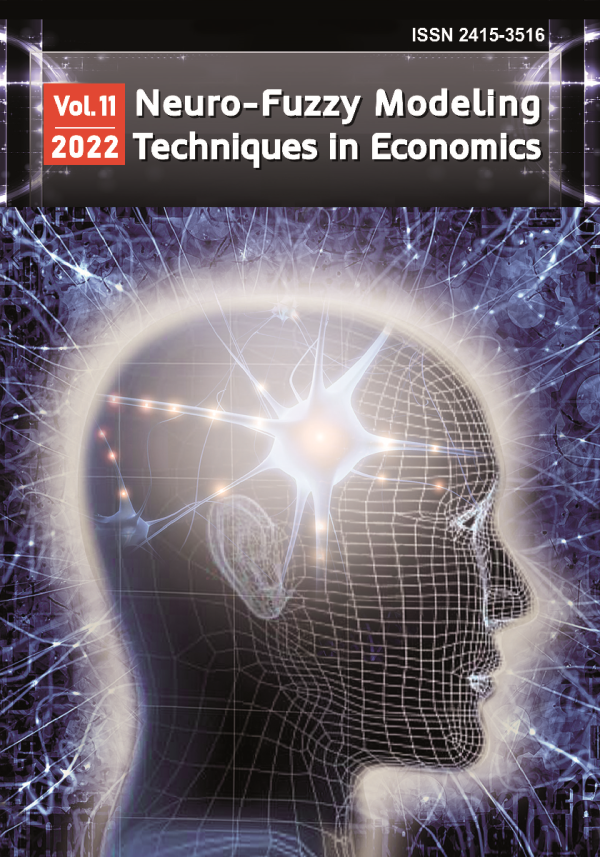
Neuro-Fuzzy Modeling Techniques in Economics
ISSN 2415-3516
Побудова ансамблів моделей кредитного скорингу
Building the ensembles of credit scoring models
DOI:
10.33111/nfmte.2018.034
Анотація: Стаття присвячена вирішенню актуального завдання підвищення ефективності оцінювання кредитних ризиків позичальників‐фізичних осіб шляхом пошуку оптимального поєднання результатів розрахунків окремих скорингових моделей. Наведено принципи формування ансамблів моделей і проаналізовано існуючі підходи побудови ансамблевих структур. У процесі експериментального дослідження застосовано одну з модифікацій алгоритму бустінгу та реалізовано авторський алгоритм побудови ансамблю моделей на основі спеціалізації експертів. У якості окремих моделей‐експертів використовувались нейромережі радіально‐базисної архітектури. В результаті проведення порівняльного аналізу ефективності використаних ансамблевих технологій визначено, що найадаптованішою для задачі оцінювання кредитного ризику є запропонований авторами алгоритм побудови ансамблю на основі спеціалізації експертів.
Abstract: The article is devoted to solving the actual problem of increasing the efficiency of assessing the credit risks of individual borrowers by finding the optimal combination of the results of calculations of specific scoring models. The principles of the formation of an ensemble of models are given and the existing approaches to the construction of ensemble structures are analyzed. In the process of experimental research has been applied one of the modifications of the boosting algorithm and implemented the author’s algorithm for constructing an ensemble of models based on the specialization of experts. The radial‐basis function neural networks were used as specific expert models. As a result of a comparative analysis of the efficiency of the used ensemble technologies it was confirmed that the algorithm for constructing an ensemble based on the specialization of experts proposed by the authors is the most adapted for the task of assessing credit risk.
Ключові слова: кредитний ризик, скорингова модель, радіально-базисна нейронна мережа, ансамбль (комітет) моделей, бустінг
Key words: credit risk, scoring model, radial-basis function (RBF) network, ensemble (committee) of models, boosting
УДК: 519.86:336.717
UDC: 519.86:336.717
JEL: C45 D81 G21
To cite paper
In APA style
Velykoivanenko, H., Savina, S., Kolechko, D., & Ben’, V. (2018). Building the ensembles of credit scoring models. Neuro-Fuzzy Modeling Techniques in Economics, 7, 34-77. http://doi.org/10.33111/nfmte.2018.034
In MON style
Великоіваненко Г.І., Савіна С., Колечко Д., Бень В. Побудова ансамблів моделей кредитного скорингу. Нейро-нечіткі технології моделювання в економіці. 2018. № 7. С. 34-77. http://doi.org/10.33111/nfmte.2018.034 (дата звернення: 03.12.2025).
With transliteration
Velykoivanenko, H., Savina, S., Kolechko, D., Ben’, V. (2018) Pobudova ansambliv modelei kredytnoho skorynhu [Building the ensembles of credit scoring models]. Neuro-Fuzzy Modeling Techniques in Economics, no. 7. pp. 34-77. http://doi.org/10.33111/nfmte.2018.034 [in Ukrainian] (accessed 03 Dec 2025).
 # 7 / 2018
# 7 / 2018
Download Paper

525
Views
138
Downloads
1
Cited by
- Miller, G. A. (1956). The Magic Number Seven Plus or Minus Two: Some Limits on Our Capacity for Processing Information. Psychological Review, 63, 81–97.
- Flach, P. A. (2012). Machine Learning: The Art and Science of Algorithms that Make Sense of Data. Cambridge, UK: Cambridge University Press.
- Terekhov, S. A. (2007). Genialniye komitety umnykh mashyn. IX Vserossijskaya nauchno-tekhnicheskaya konferenciya «Nejroinformatika-2007»: Lekcii po nejroinformatike (Moscow, Russia: MIFI) (IX All-Russian scientific and technical conference «Neuroinformatics-2007»: Lectures on neuroinformatics), 2, 11—42 [in Russian].
- Schapirе, R. E. (1990). The Strength of Weak Learnability. Machine Learning, 5(2), 197–227. Retrieved from http://rob.schapire.net/papers/strengthofweak.pdf.
- Freund, Y., & Schapire, R. E. (1997). A decision-theoretic generalization of on-line learning and an application to boosting. Journal of Computer and System Sciences, 55(1), 119–139. Retrieved from http://www.face-rec.org/algorithms/Boosting-Ensemble/decision-theoretic_generalization.pdf.
- Breiman, L. (2001, January). Random forest. Berkeley, CA: Statistics Department of University of California. Retrieved from https://www.stat.berkeley.edu/~breiman/randomforest2001.pdf.
- Kuznecov, I.A., & Kireev, V.S. (2016, October 11-14). Razrabotka ansamblya algoritmov klassifikacii s ispol’zovaniem entropijnogo pokazatelya kachestva dlya resheniya zadachi povedencheskogo skoringa. Trudy XVIII Mezhdunarodnoj konferencii DAMDID/RCDL’2016 «Analitika i upravlenie dannymi v oblastyah s intensivnym ispol’zovaniem dannyh» (Yershovo, Russia) (Proceedings of XVIII International Conference «Analytics and Data Management in Data-Intensive Areas»), 11—42. Retrieved from http://ceur-ws.org/Vol-1752/paper07.pdf [in Russian].
- Paklin, N. B., & Oreshkov, V. I. (2013). Biznes-analitika: ot dannykh k znaniyam. St. Petersburg, Russia: Piter [in Russian].
- Haykin, S. (1998). Neural Networks — A Comprehensive Foundation, Second Edition. New Jersey: Prentice-Hall.
- Lavrenkov Yu. N. (2014). Issledovanie i razrabotka kombinirovanyh nejrosetevyh tekhnologij dlya povysheniya effektivnosti bezopasnoj marshrutizacii informacii v setyah svyazi: PhD Thesis. Kaluga, Russia: MSTU named after N.E. Baumana. Retrieved from https://mpei.ru/Science/Dissertations/dissertations/Dissertations/LavrenkovYN_diss.pdf [in Russian].
- Savina, S. S., & Ben’, V. P. (2015). Objednannia modelej logit-rehresiyi yak komitetu ekspertiv dlia otsinky kredytospromozhnosti pozychal’nyka. Nejro-nechitki tekhnolohii modeliuvannia v ekonomitsi (Neuro-Fuzzy Modeling Technigues in Economics), 4, 154—188 [in Ukrainian].
- Savina, S. S., & Ben’, V. P. (2016). Vybіr arhіtektury nejromerezhі dlya rozv’yazannya zadachі klasyfіkacіyi nadіjnostі pozychal’nykіv-fіzychnyh osіb. Nejro-nechitki tekhnolohii modeliuvannia v ekonomitsi (Neuro-Fuzzy Modeling Technigues in Economics), 5, 123—151 [in Ukrainian].
- Caregorodcev, V. G. (2004). Optimizacija ekspertov boosting-kollektiva po ih krivym obuchenija. Materialy XIII Vserossiyskogo seminara «Nejroinformatika i ee prilozhenija» (Krasnoyarsk, Russia), (Proceedings of XIII All-Russian Seminar «Neuroinformatics and its applications»), 152—157 [in Russian].
- Schapire, R. E. (1999). Theoretical views of boosting and applications. Proceedings of 10th International Conference «Algorithmic Learning Theory» (Tokyo, Japan). Retrieved from http://www-ai.cs.uni-dortmund.de/LEHRE/PG/PG445/literatur/schapire_99a.pdf.
- Matviychuk, A. V. (2011). Shtuchnyi intelekt v ekonomitsi: neironni merezhi, nechitka logika. Kyiv, Ukraine: KNEU [in Ukrainian].

